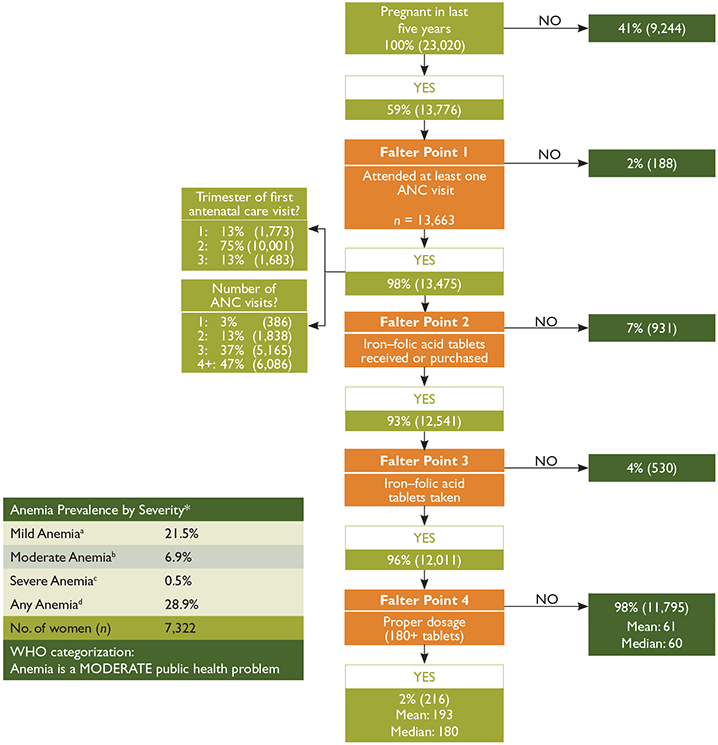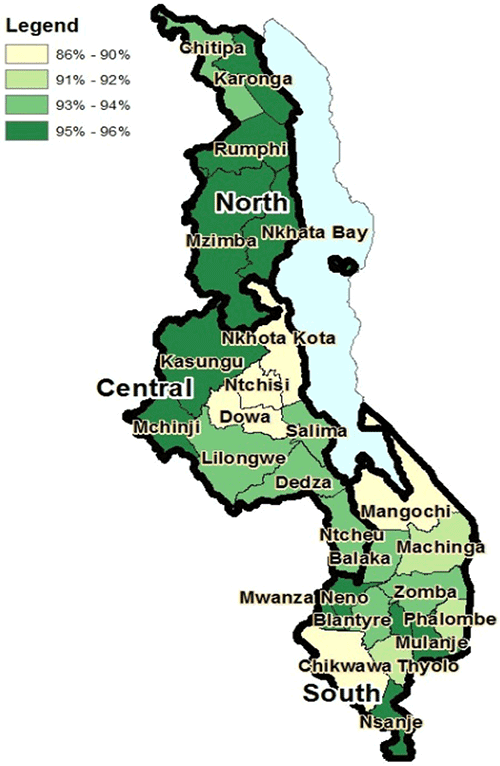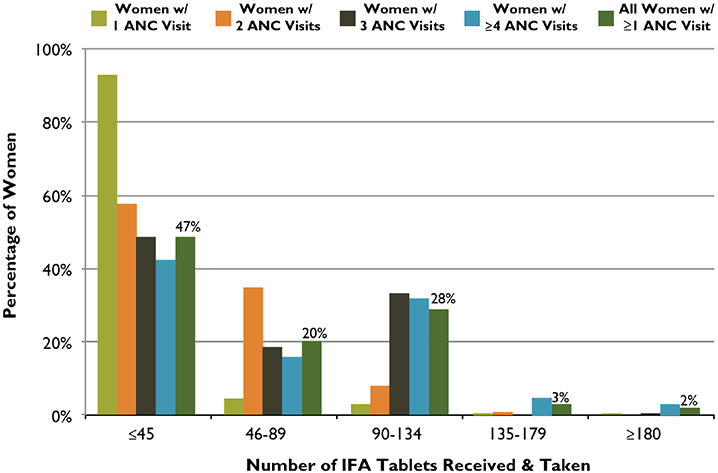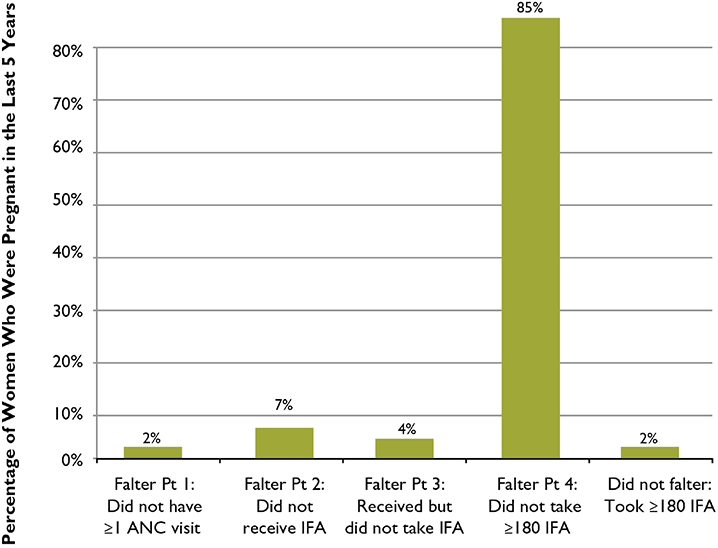Overview of the Global Anemia Problem, Including Iron Deficiency Anemia
The World Health Organization (WHO) defines anemia among women of childbearing age as the condition of having a hemoglobin concentration of <12.0 g/dL at sea level; among pregnant women it is defined as < 11.0 g/dL. The hemoglobin concentration cutoff level that defines anemia varies by age, gender, physiological status, smoking status, and the altitude at which the assessed population lives.
The primary cause of anemia is iron deficiency, a condition caused by inadequate intake or low absorption of iron, the increased demands of repeated pregnancies—particularly if not well spaced (e.g., fewer than 36 months between pregnancies)—and loss of iron through menstruation. Other causes of anemia include vitamin deficiencies (such as a deficiency of folic acid or vitamin A), genetic disorders, malaria, parasitic infections, HIV, tuberculosis, common infections, and other inflammatory conditions. While iron deficiency anemia (IDA) accounts for about one-half of all anemia cases, it often coexists with these other causes.
Iron deficiency anemia is most common during pregnancy and in infancy, when physiological iron requirements are the highest and the amount of iron absorbed from the diet is not sufficient to meet many individuals’ requirements (Stoltzfus and Dreyfuss 1998). Anemia’s effects include increased risk of premature delivery, increased risk of maternal and child mortality, negative impacts on the cognitive and physical development of children, and reduced physical stamina and productivity of people of all ages (Horton and Ross 2003). Globally, IDA annually contributes to over 100,000 maternal deaths (22 percent of all maternal deaths) and over 600,000 perinatal deaths (Stoltzfus, Mullany, and Black 2004). Key anemia control interventions include promoting a diversified diet, iron-folic acid (IFA) supplementation during pregnancy, iron fortification of staple foods, prevention and treatment of malaria, use of insecticide-treated bed nets, helminth prevention and control, delayed cord clamping, and increased birth spacing.
Maternal Anemia in Malawi
The prevalence rate of anemia among pregnant women in Malawi is 38 percent, making it a moderate public health problem as defined by WHO standards1 (NSO and ICF Macro 2011). In terms of anemia severity, the majority of cases among pregnant and non-pregnant women reported in the 2010 Malawi Demographic and Health Survey (MDHS) are classified as mild or moderate.2 Less than one percent of anemia cases in pregnant women are diagnosed as severe. Geographically and by urban/rural residency, there is little variation from the national prevalence of maternal anemia. The most marked differences are by education level, and the relationship is surprising: the prevalence of anemia among pregnant women with no education is 35 percent, compared with 50 percent of pregnant women with a secondary education (NSO and ICF Macro 2011).
Falter Points in Women's Consumption of Iron-Folic Acid During Pregnancy
WHO recommends that all pregnant women receive a standard dose of 30–60 mg iron and 400 μg folic acid beginning as soon as possible during gestation (WHO 2012a). Ideally, women should receive iron-containing supplements no later than the first trimester of pregnancy, which means ideally taking 180 tablets before delivery. It is important to note, that many countries aim for women to receive 90 or more tablets during pregnancy.
Figure 1 shows a decision-tree analysis of how well the Malawian antenatal care (ANC) system distributes IFA, and identifies four potential points at which the system might falter (highlighted in orange). The figure tracks the number and percentage of women who obtained ANC, those who subsequently received and consumed at least one IFA tablet, and those who consumed the ideal minimum number of tablets.3 All data are based on MDHS questions asked of women who were in permanent unions and had been pregnant in the five years prior to being interviewed4 (NSO and ICF Macro 2011).
Figure 1. Analysis of Falter Points Related to Distribution and Consumption of IFA through Malawi’s ANC Program in 2010, Women of Reproductive Age (15–49 Years) n = 23,020

Main Conclusions: Malawi’s high ANC coverage makes it a strong vehicle for IFA distribution. Among women who were pregnant in the last five years, had at least one ANC visit, and took at least one IFA tablet, only two percent received and took the ideal minimum number of tablets. The critical shortcoming is Falter Point 4. Both supply and demand are likely constraints.
*Percentage of women 15–49 years based on Hemoglobin levels, Hb (g/dL)
aNPW 10.0≤Hb≤11.9, PW 10≤Hb≤10.9 bNPW 7.0≤Hb≤9.9 cNPW Hb<7.0, PW Hb<7.0 dNPW Hb<12.0, PW Hb<11.0
Non-responses, no data (NR/ND) were recoded to “No” for “IFA tablets received?”, and “IFA tablets taken?” and to zero for “Number of tablets taken?”.
Anemia prevalence data are provided as a reference point, signaling the general order of magnitude of the anemia public health problem. The ANC utilization data is based on self-reported data of women 15–49 years in permanent unions and pertains to their last pregnancy in the last five years prior to the DHS survey.
Source: Calculations and anemia levels are from the Malawi Demographic and Health Survey (2010).
Many supply-side aspects—including both adequacy of IFA tablet supplies and technical knowledge and practices of ANC providers—need to be considered when assessing how well an ANC program delivers IFA. In addition, as Falter Point 4 in Figure 1 clearly shows, the provision of IFA tablets to a pregnant woman is a necessary but not sufficient condition for the woman to consume the tablets, particularly at the ideal minimum level. Thus, demand-side factors also play a critical role in determining the coverage and effectiveness of a program. These include whether or not women seek ANC and the timing and number of visits, as well as the extent to which women are aware of the significance of anemia and IFA, ask for IFA tablets, and comply with the IFA regimen.
Understanding the relative significance of each falter point makes it possible to prioritize them for more in-depth analysis, providing a first step in an evidence- based approach to systematically improving the program. The DHS does not collect information on the number of IFA tablets received by women. In the case of Falter Point 4, this lack of data creates ambiguities that make it impossible to fully understand whether shortcomings of the system relate primarily to supply- or demand-side factors. Despite this limitation, the decision-tree analysis presented in Figure 1 still enables prioritizing the falter points for more in-depth analysis and action at the national, district, and health center levels.
Analysis of Falter Points
Falter Point 1:
Did not attend at least one ANC visit
Only two percent of women did not have at least one ANC visit.
ANC’s very high coverage gives it great potential as a vehicle for providing IFA.
Falter Point 2:
Did not receive or purchase at least one IFA tablet
Of the women who had at least one ANC visit, seven percent did not receive or purchase any IFA tablets.
This supply-side constraint is relatively small and may be due to various system/supply-side performance shortcomings, which could reflect: (1) inadequate supply (e.g., stockouts); (2) inadequate provider knowledge; or (3) inadequate provider practices, whereby IFA may not have been provided.
Unfortunately, the MDHS does not report the source(s) of the IFA tablets women received or purchased. However, women who attend ANC may be more likely to be aware of, to value, and also to take IFA tablets, regardless of where they obtain them. Thus, we would expect a high correlation between the number of women who had at least one ANC visit and those who received or purchased IFA, which is consistent with the data. While less than one percent of Malawian women who received or purchased IFA did not have any ANC visits (not shown), we cannot ascertain whether or not those who received ANC obtained their IFA from their ANC provider. What is known, however, is that women who had one or more ANC visits and who did not receive any IFA represent a missed opportunity to reduce the risk of anemia among a high-risk population.
Falter Point 3:
Did not take at least one IFA tablet
Of the women who received IFA, four percent did not consume any tablets.
This demand-side constraint is relatively small and may be due to women not understanding the significance of anemia and/or the significance of IFA. This misunderstanding may reflect: (1) inadequate provider counseling and follow-up; (2) women’s beliefs about actual or possible side effects; or (3) sociocultural factors.
Falter Point 4:
Did not consume 180 or more IFA tablets
Of the women who received and took IFA, 98 percent did not consume the ideal minimum of 180 tablets.
This constraint results from a combination of supply- and/or demand-side factors. Figure 1 suggests two situations that may contribute to this falter point: 88 percent of women who received ANC began their care after the first trimester, and the 53 percent who had fewer than WHO’s recommended four ANC visits during their last pregnancy may have started their ANC too late or may not have had enough visits to receive 180 tablets (given IFA distribution protocols). Both of these scenarios are likely contributors, but further research is needed to establish their relative importance, as well as the significance of other possible causes.
Globally, research has found that the following situations often contribute to Falter Point 4: (1) providers do not have access to adequate supply; (2) women do not receive adequate tablets because they have little access to care, start ANC late, or do not have enough ANC visits, making it difficult to obtain 180 tablets (given IFA distribution protocols); (3) providers do not provide adequate counseling or follow-up; (4) women do not adhere to the regimen, which may be due to difficulty in remembering to take the tablets daily, not knowing all the tablets are necessary, fear of having a big baby, side effects, or tablet-related issues (taste, size, color, coating, packaging/storage problem). Further research is needed to determine the underlying factors contributing to this falter point in Malawi.
Analysis by Sociodemographic Variables and Trends over Time
A comparison of 2004 and 2010 data reveals that Malawi has made substantial progress in addressing maternal anemia: (1) ANC coverage rose from 95.1 percent to 98.4 percent; and (2) the percentage of women who had at least one ANC visit and took iron tablets or syrup increased from 79.4 percent to 91.2 percent.
Table 1 shows only very small variations in the coverage of Malawi’s ANC program and consumption of IFA tablets across regions, urban/rural residence area, and wealth. The degree of equity in both the ANC coverage rates and in the percentage of women who took at least one IFA tablet across all three characteristics analyzed Table 1 is striking, and not common in other countries. A comparison of these 2010 estimates with 2004 data (not shown) reveals that while these percentages have all edged upward over this period, they were already high in 2004. The greatest gains made over the six-year period were in rural areas and among the lowest 40 percent in wealth. Malawi has been improving the ANC-based distribution of IFA and doing so in a way that is propoor, and, more generally, has increased equity.
Table 1. ANC Coverage and IFA Tablets Taken During Last Pregnancy in the Last Five Years by Region, Residence and Wealth, Malawi, 2010
| Characteristic | No. of Women with Live Births - Last 5 Years* | Received ANC | Took 1 + IFA Tablets | ||
|---|---|---|---|---|---|
| Number | Percent | Number | Percent | ||
| Region | |||||
| Residence | |||||
| Wealth | |||||
| Northern | 1,595 | 1,585 | 99.4% | 1,507 | 94.5% |
| Central | 5,819 | 5,683 | 97.7% | 5,266 | 90.5% |
| Southern | 6,251 | 6,175 | 98.8% | 5,688 | 91.0% |
| Urban | 2,107 | 2,077 | 98.6% | 1,953 | 92.7% |
| Rural | 11,558 | 11,367 | 98.3% | 10,506 | 90.9% |
| Lowest 40% | 5,715 | 5,587 | 97.8% | 5,152 | 90.2% |
| Highest 40% | 5,044 | 4,991 | 98.9% | 4,663 | 92.4% |
| National Average | 13,664 | 13,443 | 98.4% | 12,462 | 91.2% |
Analysis by Geographic Region
The map in Figure 2 shows the percentage of women who had at least one ANC visit and reported receiving at least one IFA tablet. The rates are consistently high.
Figure 2. Percentage of Women Who Had at Least One ANC Visit and Received at Least One IFA Tablet by Region, Malawi, 2010

Although Malawi’s 29 percent nationwide prevalence rate of anemia among women of childbearing age is categorized as a moderate public health problem, there are regions in which anemia remains a severe issue. By WHO standards for the severity of anemia prevalence rates, Mangochi, with a 50.5 percent prevalence rate, should be the top regional priority, followed by Nsanje (48 percent), as both regions are categorized according to WHO as having severe prevalence of anemia.
Analysis by Number of ANC Visits
Figure 3 shows the relationship between the number of IFA tablets taken by women who had at least one ANC visit, and the number of ANC visits they had during their last pregnancy. Forty-seven percent of the women who had at least one ANC visit took at most one-quarter (45) of the ideal minimum number of IFA tablets. While women with more visits were generally likely to receive and take more IFA tablets, the relationship is not linear. The quantity of IFA tablets taken generally reaches a maximum at less than three-quarters of the ideal minimum (< 135 tablets), regardless of how many ANC visits women may have had. While it is commendable that 28 percent of women took 90–135 tablets, learning what accounts for this ceiling can assist in ensuring that more women receive and consume the ideal number of IFA tablets.
Figure 3. ANC Distribution of IFA Tablets: Number of Tablets Received and Taken According to Number of ANC Visits, Malawi, 2010

Overall Conculsions and Recommendations
Figure 4 presents the obstacles among all women, including those who did not receive ANC during their pregnancy, to taking the ideal minimum number of IFA tablets. Based on this analysis, Malawi’s system of IFA tablet distribution through the ANC platform is very promising, with only Falter Point 4 constituting a significant barrier. Improving the delivery of IFA supplementation in Malawi will require better understanding the causes of Falter Point 4. Diminishing the impact of this falter point may involve identifying and addressing program gaps in IFA supply management, health workers’ practices, and women’s long-term adherence behaviors as well as addressing other points mentioned above, under “Analysis of Falter Points.”
Figure 4. Relative Importance of Each of the Falter Points in Malawi: Why Women Who Were Pregnant in the Last Five Years Failed to Take the Ideal Minimum of 180 IFA Tablets

Malawi’s maternal mortality rate (MMR) is estimated to be 460 maternal deaths per 100,000 live births, which ranks 21st among 181 countries (WHO 2012b). Although Malawi has made great strides in reducing its MMR since 2000 (when it exceeded 1,100), it is expected to fall well short of its Millennium Development Goal (MDG) 5 target of 115. To accelerate its progress toward achieving its MDG 5 goal, Malawi should conduct additional studies, especially related to Falter Point 4, to identify and prioritize obstacles to the as-yet-unrealized potential of its ANC-based IFA distribution, so that it can begin systematically addressing these shortcomings. Given that 78 percent of Malawian women who had at least one ANC visit received their care in a public facility (NSO and ICF Macro 2011), Ministry of Health facilities should be the focus of this work. However, the sizable proportion of women who receive their ANC at private clinics suggests that targeting these facilities may also improve national access to and consumption of IFA tablets.
Improving the distribution of IFA through the ANC program is an important strategy for preventing and controlling anemia in Malawi, and for improving the nutrition and health status as well as the mental and physical capacity of women of reproductive age.
Footnotes
1 WHO categorizes the severity of anemia as a public health problem according to the condition’s prevalence: <5 percent, no public health problem; 5–19.9 percent, mild; 20–39.9 percent, moderate; ≥40 percent, severe.
2 The DHS hemoglobin levels used to diagnose the severity of anemia in non-pregnant women differ from those specified by WHO. The DHS cutoffs for pregnant (P) and non-pregnant (NP) women in hemoglobin g/dL are mild, 10.0–10.9 (P), 10.0–11.9 (NP); moderate, 7.0–9.9 (P), 7.0–9.9 (NP); severe, <7.0 (P), <7.0 (NP); any, < 11.0 (P), <12.0 (NP).
3 The MDHS asked about IFA tablets or capsules; this brief refers to all forms as “tablets.”
4 The MDHS provides a population-based, nationally representative sample of all women in Malawi.
References
Horton, S., and J. Ross. 2003. “The Economics of Iron Deficiency.” Food Policy 28(1):51–75.
Ministry of Development Planning and Cooperation (MDPC) [Malawi]. 2010. 2010 Malawi Millennium Development Goals Report. Lilongwe: MDPC.
National Statistical Office (NSO) [Malawi] and ICF Macro. 2011. Malawi Demographic and Health Survey 2010. Zomba, Malawi, and Calverton, MD: NSO and ICF Macro.
National Statistical Office (NSO) [Malawi], and ORC Macro. 2005. Malawi Demographic and Health Survey 2004. Calverton, MD: NSO and ORC Macro.
Office of the President and Cabinet [Malawi]. 2008. Infant and Young Child National Nutrition Policy and Strategic Plan. Lilongwe: Government of Malawi.
Soltzfus, R. J., L. Mullany, and R. E. Black. 2004. “Iron Deficiency Anemia.” In Comparative Quantification of Health Risks: Global and Regional Burden of Disease Attributable to Selected Major Risk Factors. M. Ezzati, A. D. Lopez, A. Rodgers, and C. J. L. Murray, eds. Geneva: World Health Organization.
Stoltzfus, R. J., and M. L. Dreyfuss. 1998. Guidelines for the Use of Iron Supplements to Prevent and Treat Iron Deficiency Anemia. Washington, DC: ILSI Press.
World Health Organization (WHO). 2012a. “Guideline: Daily Iron and Folic Acid Supplementation in Pregnant Women.” Geneva: WHO.
World Health Organization (WHO). 2012b. Indicator and Measurement Registry, version 1.6.0. Maternity mortality rate.